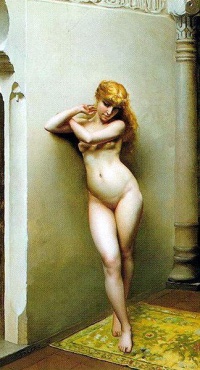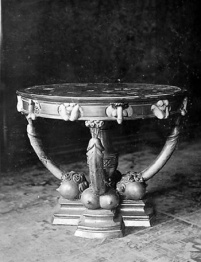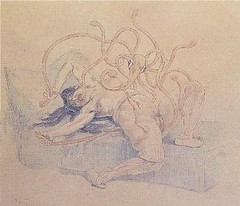Paul Rumsey is a British artist working in the tradition of the fantastique.
Category Archives: eroticism
Icons of erotic art #19
Venus (1532) by Lucas Cranach the Elder
From March 8 until June 8, 2008, the London Royal Academy of Arts will hold a retrospective of Cranach’s work. This advertising poster for the Cranach expo (which displays the Venus painting) was recently considered offensive to the officials of the London Underground, who banned it and stated that
“Millions of people travel on the London Underground each day and they have no choice but to view whatever adverts are posted there. We have to take account of the full range of travellers and endeavour not to cause offence in the advertising we display.”
Lucas Cranach the Elder (Lucas Cranach der Ältere, 1472 – 1553) was a German painter and printmaker in woodcut and engraving of the school now known as Northern Renaissance. His influence is readily displayed in the work of 21st century American artist John Currin [1].
Previous entries in Icons of Erotic Art here, and in a Wiki format here.
Breton’s homophobia
I’ve mentioned surrealist leader André Breton’s homophobia before, so I decided to investigate.
Apparently most of what is known of Breton’s dislike of homosexuality stems from round table discussions that were held in the years 1928 – 1932, long before Kinsey or Masters and Johnson began their clinical surveys. Participants included many of surrealism’s best known figures: Andre Breton, Paul Eluard, Louis Aragon, Max Ernst, Man Ray, Antonin Artaud, Benjamin Peret, Jacques Prevert, Marcel Duhamel, Yves Tanguy, Pierre Unik, etc…. Their findings were partly published in the surrealist magazine La Révolution surréaliste. For those of us without access to those magazines (and that is 99.999% of us) there is an English translation available from Verso books with the title Investigating Sex: Surrealist Discussions 1928-1932, which publishes verbatim accounts of all of these round table discussions.
Quoting from both sides (pro and contra):
André Breton said:
- “I accuse homosexuals of confronting human tolerance with a mental and moral deficiency which tends to turn itself into a system and to paralyse every enterprise I respect.”
Pierre Unik states:
- “From a physical point of view, I find homosexuality as disgusting as excrement …”
André Breton concludes:
- “I am absolutely opposed to continuing the discussion of this subject. If this promotion of homosexuality carries on, I will leave this meeting forthwith.”
Some surrealists came to the defense of homosexuals, most notably Raymond Queneau who states:
- “It is evident to me that there is an extraordinary prejudice against homosexuality among the surrealists.
I’d like to investigate further who was pro and who contra, but I am running out of time here.
Icons of erotic art #18
Via the newly discovered blog aileron comes the film The Lost Secret of Catherine the Great by Peter Woditsch and Sophie Schoukens.
I had first heard about the erotic furniture of Catherine the Great a couple of years ago and even traced the existence of the documentary by Woditsch, but had never actually seen the pieces of furniture that presumedly belonged to Catherine before the collection was destroyed during WWII. Catherine was a strong and independent woman (it helped that she was an empress) who throughout her long reign, took many lovers, often elevating them to high positions for as long as they held her interest, and then pensioning them off with large estates and gifts of serfs. She also cultivated Voltaire, Diderot and D’Alembert — all French philosophes encyclopedists who later cemented her reputation in their writings.
Note: In the erotic furniture category belong art works such as Chair, Table and Hat Stand by Allen Jones and Les Krims‘s Heavy Feminist with Wedding Cake [1] (1970).
Previous entries in Icons of Erotic Art here, and in a Wiki format here.
Icons of erotic art #17

Sensuality (1891) – Franz von Stuck
Although a mediocre painter at best and deservedly one of the minor figures in European fin de siècle Symbolism, there are two paintings by Franz Von Stuck that I like: Salome, which I “exhibited” here, and Sensuality (pictured above) . In Sensuality, the image of the serpent as phallus is left in little doubt and shows an enormous python-like creature passing between the legs of a nude woman. The serpent’s head rests on the woman’s right shoulder; both the serpent and the woman gaze at the viewer. There are obvious connections to the tentacle eroticism trope.
Previous entries in Icons of Erotic Art here, and in a Wiki format here.
Gratuitous nudity #6

There is something about this pose, legs crossed, one foot put forward, that I find particularly attractive. Mabe it’s the fact that standing like this makes the rear foot tiptoe and raise the buttocks.
If anyone can help me with the date on this painting, please drop me a line.
Previous entries in this series.
Icons of erotic art #16
Frontispiece by Fernand Khnopff for Joséphin Péladan’s Istar (1888)
Istar is a novel by Joséphin Péladan first published in 1888 with a frontispiece by Fernand Khnopff, depicting a woman, head thrown back in ecstasy and completely devoid of surrounding except for a phallic tentacled plant that grows toward her pubic area.
Eroticism 4/5, because of its “his hands were all over me” thematics first celebrated in icons #12 and 13.
Previous entries in Icons of Erotic Art here, and in a Wiki format here.
World cinema classics #35
[Youtube=http://www.youtube.com/watch?v=pMI-iQdHJkE&]
Knife in the Water (1962) – Roman Polański
Knife in the Water is a 1962 film directed by Roman Polański. It features only three characters and deals with rivalry and sexual tension. Polanski would return to those themes in the 1966 film Cul-de-sac.
Previous “World Cinema Classics” and in the Wiki format here.
Icons of erotic art #13, 14 and 15
Grand bath at Bursa (1885) by Jean-Léon Gérôme
The Turkish Bath (1862) – Jean Auguste Dominique Ingres

I quote from my text on Ingres’s Turkish Bath, but the validity is for all three paintings:
When Jean Auguste Dominique Ingres, director of the French Académie de peinture painted a highly-colored vision of a turkish bath, he made his eroticized Orient publicly acceptable by his diffuse generalizing of the female forms, who might all have been of the same model. If his painting had simply been retitled “In a Paris Brothel,” it would have been far less acceptable. Sensuality was seen as acceptable in the exotic Orient.
Most of my renewed interest in these painting has been thinking about books such as the Pre-Victorian British erotic literature epistolary novel The Lustful Turk and reading Turkish author Bedri Baykam’s pamphletish but nonetheless thought provoking history of modern art Monkeys’ Right to Paint , which contends that modern art (he means modernist art) is largely influenced by non-Western arts. Baykam takes the 1984 MoMA exhibition Primitivism in 20th Century Art as a starting point for his rant against the art establishment.
Icons of erotic art #12 and 13
Previous entries in Icons of Erotic Art here, and in a Wiki format here.








